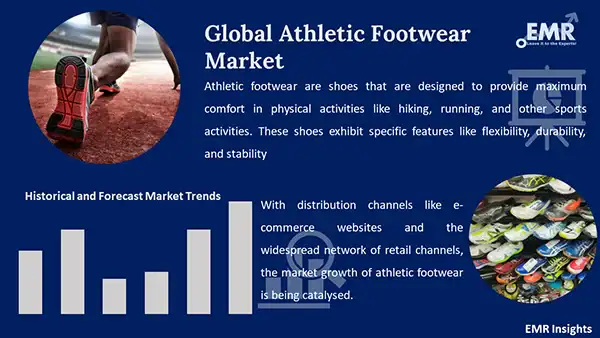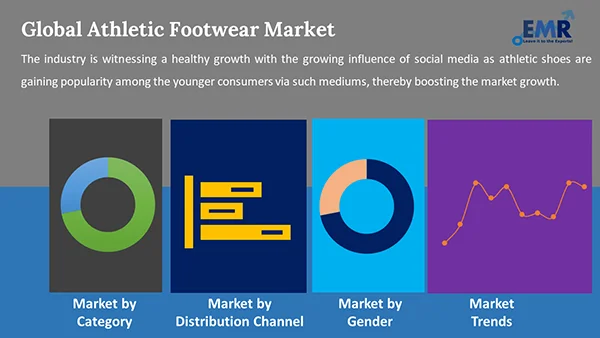
Consumer Insights
Uncover trends and behaviors shaping consumer choices today
Procurement Insights
Optimize your sourcing strategy with key market data
Industry Stats
Stay ahead with the latest trends and market analysis.
The global athletic footwear market attained a value of about USD 88.18 Billion in 2025. The market is further expected to grow at a CAGR of 5.20% during the forecast period of 2026-2035 to reach USD 146.40 Billion by 2035.
Base Year
Historical Period
Forecast Period
Compound Annual Growth Rate
5.2%
Value in USD Billion
2026-2035
*this image is indicative*
| Global Athletic Footwear Market Report Summary | Description | Value |
| Base Year | USD Billion | 2025 |
| Historical Period | USD Billion | 2019-2025 |
| Forecast Period | USD Billion | 2026-2035 |
| Market Size 2025 | USD Billion | 88.18 |
| Market Size 2035 | USD Billion | 146.40 |
| CAGR 2019-2025 | Percentage | XX% |
| CAGR 2026-2035 | Percentage | 5.20% |
| CAGR 2026-2035 - Market by Region | Asia Pacific | 5.9% |
| CAGR 2026-2035 - Market by Country | India | 6.0% |
| CAGR 2026-2035 - Market by Country | China | 5.6% |
| CAGR 2026-2035 - Market by Gender | Women | 5.7% |
| CAGR 2026-2035 - Market by Distribution Channel | Online | 11.8% |
| Market Share by Country 2025 | France | 3.1% |
The rising participation in sports activities by the younger consumers is expected to boost the market growth in the forecast period. With major sports events like the Olympics, FIFA, and Cricket World Cup being postponed during the COVID-19 pandemic in 2020, the market growth was hampered. However, as restrictions were lifted, the demand for athletic shoes for such sporting events is expected to continue augmenting the growth of the market. Furthermore, the rise in awareness regarding health and physical fitness during the pandemic, with people across all age groups taking up sporting activities like cycling, trekking, and running, among others, is projected to further drive the market growth.

Read more about this report - REQUEST FREE SAMPLE COPY IN PDF
The growing awareness of the importance of physical activities on emotional and psychological health is further projected to bolster the market growth, especially after long periods of lockdowns in 2020. In addition, the increasing awareness about the importance of using the right type of shoes to prevent leg injuries are leading to technological and innovative advancements in manufacturing practices and, hence, are anticipated to accelerate the market growth over the forecast period.

Read more about this report - REQUEST FREE SAMPLE COPY IN PDF
Athletic footwear are shoes that are designed to provide maximum comfort in physical activities like hiking, running, and other sports activities. These shoes exhibit specific features like flexibility, durability, and stability. Unlike sneakers or other types of footwear, athletic footwears are comfort and function-centric.
On the basis of category, the market is segmented into:
Based on demographic, the market is categorised into:
On the basis of distribution channel, the market is divided into:
The EMR report looks into the regional markets of athletic footwear like:
| CAGR 2026-2035 - Market by | Country |
| India | 6.0% |
| China | 5.6% |
| Brazil | 5.5% |
| UK | 5.1% |
| USA | 4.9% |
| Canada | XX% |
| Germany | 4.7% |
| France | XX% |
| Italy | XX% |
| Japan | XX% |
The rising market growth of athletic footwear can be attributed to the increasing purchasing power of consumers as a result of their rising disposable incomes. With innovations in the manufacturing process, people are willing to spend more on several performance characteristics like comfortable cushioning, waterproof quality, unique designs, and friction regulation, among others, which is also catalysing the market growth. Moreover, with the rise of distribution channels like e-commerce websites and the widespread network of retail channels, the market for athletic footwear is being augmented further. Furthermore, the industry is witnessing a healthy growth with the growing influence of social media as athletic shoes are gaining popularity among the younger consumers via such mediums, thereby boosting the market growth.
The report presents a detailed analysis of the following key players in the global athletic footwear market, looking into their capacity, market share, and latest developments like capacity expansions, plant turnabouts and mergers and acquisitions.
The comprehensive report looks at the micro and macro aspects of the industry. The EMR report gives an in-depth insight into the market by providing a SWOT analysis as well as an analysis of the Porter’s Five Forces Model.
Mexico Athletic Footwear Market




*While we strive to always give you current and accurate information, the numbers depicted on the website are indicative and may differ from the actual numbers in the main report. At Expert Market Research, we aim to bring you the latest insights and trends in the market. Using our analyses and forecasts, stakeholders can understand the market dynamics, navigate challenges, and capitalize on opportunities to make data-driven strategic decisions.*
Get in touch with us for a customized solution tailored to your unique requirements and save upto 35%!
The market attained a value of approximately USD 88.18 Billion in 2025.
The market is projected to grow at a CAGR of 5.20% in the forecast period of 2026-2035.
The market is estimated to witness a healthy growth in the forecast period of 2026-2035 to reach about USD 146.40 Billion by 2035.
The market is being driven by rising awareness regarding the benefits of fitness on physical and emotional health and the growing need for appropriate athletic footwear to prevent injuries and discomfort.
The key trends of the market include growing prevalence distribution channels like e-commerce websites, widespread network of retail channels, and growing participation of women in sports.
The major regional markets for athletic footwear are North America, Latin America, the Asia Pacific, Europe, and the Middle East and Africa.
The leading categories of athletic footwear in the market are aerobic shoes, running shoes, walking shoes, trekking and hiking shoes, and sports shoes.
The dominant genders in the market are men, women and kids.
The significant distribution channels in the market are retail stores and online.
The key players in the global athletic footwear market are Adidas AG, ASICS Corporation, Fila, Inc., Nike Inc, Reebok International Ltd., and Puma SE, among others.
Explore our key highlights of the report and gain a concise overview of key findings, trends, and actionable insights that will empower your strategic decisions.
| REPORT FEATURES | DETAILS |
| Base Year | 2025 |
| Historical Period | 2019-2025 |
| Forecast Period | 2026-2035 |
| Scope of the Report |
Historical and Forecast Trends, Industry Drivers and Constraints, Historical and Forecast Market Analysis by Segment:
|
| Breakup by Category |
|
| Breakup by Gender |
|
| Breakup by Distribution Channel |
|
| Breakup by Region |
|
| Market Dynamics |
|
| Competitive Landscape |
|
| Companies Covered |
|
| Report Price and Purchase Option | Explore our purchase options that are best suited to your resources and industry needs. |
| Delivery Format | Delivered as an attached PDF and Excel through email, with an option of receiving an editable PPT, according to the purchase option. |
Single User License
One User
USD 3,999
USD 3,599
tax inclusive*
Datasheet
One User
USD 2,499
USD 2,249
tax inclusive*
Five User License
Five User
USD 4,999
USD 4,249
tax inclusive*
Corporate License
Unlimited Users
USD 5,999
USD 5,099
tax inclusive*
*Please note that the prices mentioned below are starting prices for each bundle type. Kindly contact our team for further details.*
Flash Bundle
Small Business Bundle
Growth Bundle
Enterprise Bundle
*Please note that the prices mentioned below are starting prices for each bundle type. Kindly contact our team for further details.*
Flash Bundle
Number of Reports: 3
20%
tax inclusive*
Small Business Bundle
Number of Reports: 5
25%
tax inclusive*
Growth Bundle
Number of Reports: 8
30%
tax inclusive*
Enterprise Bundle
Number of Reports: 10
35%
tax inclusive*
How To Order

Select License Type
Choose the right license for your needs and access rights.

Click on ‘Buy Now’
Add the report to your cart with one click and proceed to register.

Select Mode of Payment
Choose a payment option for a secure checkout. You will be redirected accordingly.
Gain insights to stay ahead and seize opportunities.

Get insights & trends for a competitive edge.

Track prices with detailed trend reports.

Analyse trade data for supply chain insights.

Leverage cost reports for smart savings

Enhance supply chain with partnerships.

Connect For More Information
Our expert team of analysts will offer full support and resolve any queries regarding the report, before and after the purchase.
Our expert team of analysts will offer full support and resolve any queries regarding the report, before and after the purchase.
We employ meticulous research methods, blending advanced analytics and expert insights to deliver accurate, actionable industry intelligence, staying ahead of competitors.
Our skilled analysts offer unparalleled competitive advantage with detailed insights on current and emerging markets, ensuring your strategic edge.
We offer an in-depth yet simplified presentation of industry insights and analysis to meet your specific requirements effectively.
Share